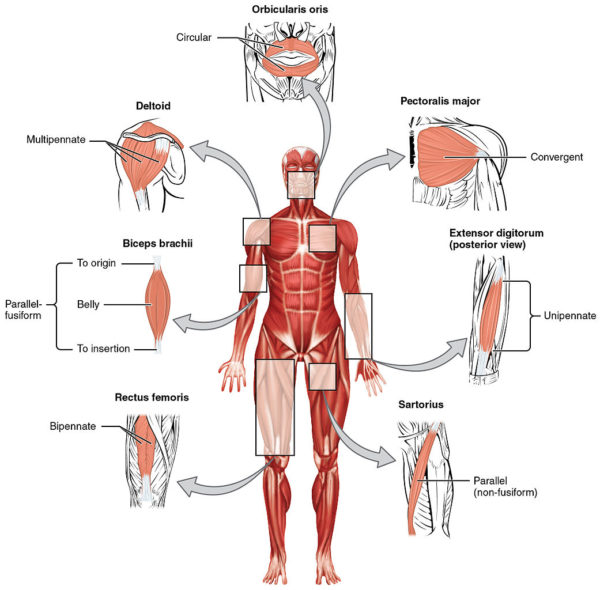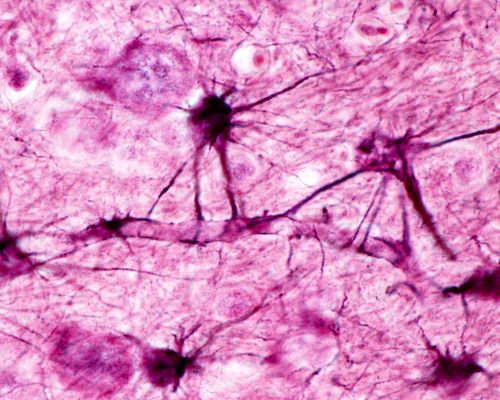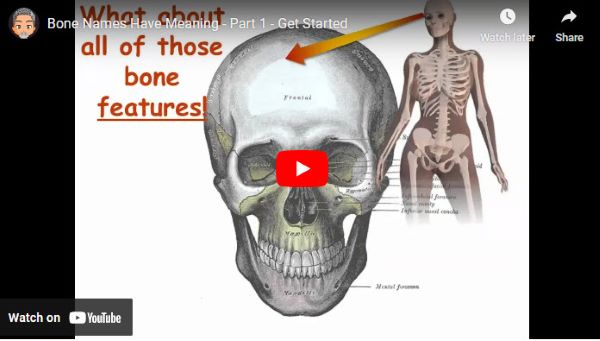Learning anatomy’s repetitious root words
Do you need help learning anatomy? Do you find the volume of new words you must learn for human anatomy to be an overwhelming challenge? Are you having a hard time recalling these strange anatomic names at test time? Would it help if you could condense your new word list by finding repetition in the Latin phrases?

Various shapes used by skeletal muscle to convert linear into angular movement, OpenStax College/Wikimedia Commons
History tells us that early anatomists studied whole humans. As they carefully dissected, they named human body parts in the sequence that they discovered them.
To simplify the naming process, they began with a group of Latin and Greek root words that they repeatedly used as prefixes and suffixes as descriptive adjectives or nouns. A list of their root words can be found by clicking here.
The first thing you want to do is to survey the Greek and Latin root words that are used most often in anatomy and medicine. Click the link above and make a copy of the page for reference. Do not try to memorize the list!
Rather, as you come to new words in your book or in lecture, compare them to your reference list of Latin and Greek suffixes and prefixes. When strung together the root words are like short descriptive sentences. This will improve your understanding of why the composite word came into use.
Anatomic systems
Your textbook authors try to simplify the known complexity of human anatomy by dividing whole humans into anatomic systems such as skeletal, muscular, nervous and so forth. Then they present the systems as layers. It is up to you at the end of your course to assemble the systems together in your mind to make a whole human.
So, it is not surprising that you might miss the repetition that occurs between bone names, muscle names, names of blood vessels and nerves. Observing the patterns and translating the descriptions originally used in naming human anatomical parts will help your mind create links that will enhance your recall at test time.
For example, you will frequently see the use of ‘-cyte’ as a suffix. It is from Greek and it means ‘a hollow vessel’. In anatomy it and its prefix form ‘cyto-’ always refer to cells, the smallest building blocks of the body. A leukocyte is a cell that is the color white, because leuko- is a Greek word meaning clear or white.
You will also come across oocyte (ovum cell) , spermatocyte (sperm cell), chondrocyte (cell that secrete collagen), astrocyte (star-shaped cell), keratinocyte (cell that make keratin), osteocyte (bone cell), and erythrocyte (red blood cell) to name just a few. The word before the suffix always describes a characteristic of that cell type.
Next, see how many words in your book use the prefix cyto-. For example, what do you think cytogenetics might mean, or cytochemistry? When your mind understands the logic behind components of anatomical composite descriptive words, it will bring them readily to the surface as you fill in the blanks of test questions.
Once translated, anatomical names become connected in your mind to familiar objects. Familiar objects are easy to remember.
Bone names have meaning
In this video Dr. Kevin Patton explains how the naming scheme works for the skeletal system. If you like this video, check out Dr. Patton’s other videos on YouTube about muscle names and more.
Further reading
Do you have questions?
Please put your questions in the comment box or send them to me by email at DrReece@MedicalScienceNavigator.com. I read and reply to all comments and email.
If you find this article helpful share it with your fellow students or send it to your favorite social media site by clicking on your favorite social media button.
Margaret Thompson Reece PhD, physiologist, former Senior Scientist and Laboratory Director at academic medical centers in California, New York and Massachusetts is now Manager at Reece Biomedical Consulting LLC.
She taught physiology for over 30 years to undergraduate and graduate students, at two- and four-year colleges, in the classroom and in the research laboratory. Her books “Physiology: Custom-Designed Chemistry”, “Inside the Closed World of the Brain”, and her online course “30-Day Challenge: Craft Your Plan for Learning Physiology”, and “Busy Student’s Anatomy & Physiology Study Journal” are created for those planning a career in healthcare. More about her books is available at https://www.amazon.com/author/margaretreece. You may contact Dr. Reece at DrReece@MedicalScienceNavigator.com, or on LinkedIn.
Dr. Reece offers a free 30 minute “how-to-get-started” phone conference to students struggling with human anatomy and physiology. Schedule an appointment by email at DrReece@MedicalScienceNavigator.com.



